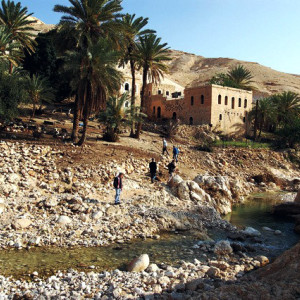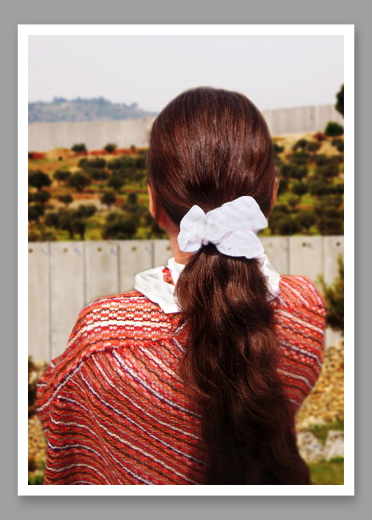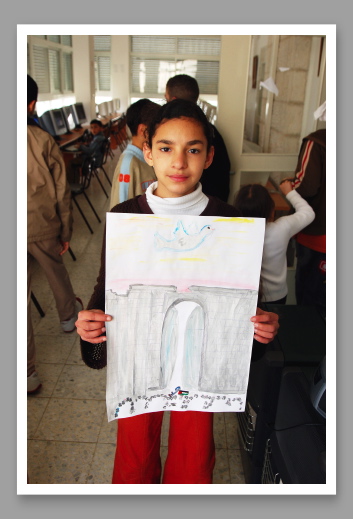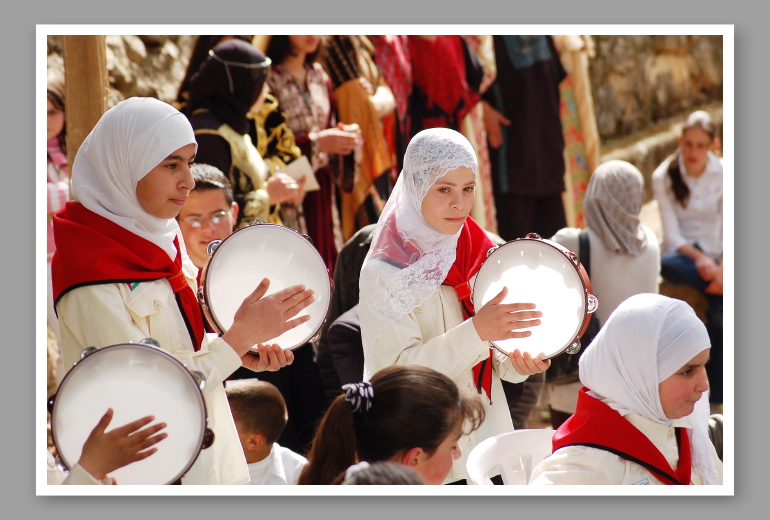 |
| This church in Bethlehem has been cut off from Jerusalem just a kilometer away on the other side of the Apartheid Wall. |
 |
| This isolated Bedouin house and goat farm at a rare oasis is only accessible by foot. |
If this isn't a picture of Palestinian sumud, idk what is pic.twitter.com/cJle6RLi1F
— national mercurity (@onekade) September 20, 2014
This is the Wikipedia definition, which begins a long entry.Sumud (Arabic: صمود) meaning "steadfastness" or "steadfast perseverance" is an ideological theme and political strategy that first emerged among the Palestinian people through the experience of the dialectic of oppression and resistance in the wake of the 1967 Six-Day War. Those who are steadfast, that is those who exhibit sumud, are referred to as samidin, the singular forms of which are samid (m.) and samida (f.). With the passing of the years since 1967, Palestinians have distinguished between two main forms of sumud. The first, static sumud, is more passive and is defined by Ibrahim Dhahak as the "maintenance of Palestinians on their land." The second, resistance sumud (in Arabic, sumud muqawim) is a more dynamic ideology whose aim is to seek ways of building alternative institutions so as to resist and undermine the Israeli occupation of the Palestinian territories. The ultimate symbol associated with the concept of sumud and the Palestinian sense of rootedness in the land is the olive tree, ubiquitous throughout Palestine. Another icon of sumud that has often been portrayed in Palestinian artwork is that of the mother, and more specifically, a peasant woman depicted as when with child.
It is a delightful irony that the initials AEI are shared by both this Arab Educational Institute and the American Enterprise Institute, one of America's oldest, most venerable conservative think tanks -- which puts these two organizations at political polar opposites, I'm sure, regarding Palestinian-Israeli politics. The only difference between the two urls is the addition of the word "center" to Palestinian website.
The reader is urged drill into the links and discover more about this organization and concept. I have known for some time that there has been a non-violent dimension to Palestinian resistance to Israel's protracted seizure of the Occupied Territories, but I didn't know about this quiet but durable group, a project of Pax Christi (one of the Catholic Church's less well-known traditions). This is from the "History" section of the site.
AEI–Open Windows is a Palestinian organization that furthers education, peace building and dialogue in the Palestinian cities of Bethlehem, Ramallah and Hebron. After the Institute’s creation in 1986 its locality in central Bethlehem was used for providing classes to Palestinian youth on a broad variety of subjects, including computer programs, business administration and languages. While being forced to intermittently close and open during the first Intifada, the AEI provided complementary and remedial coaching programs for youth while schools were closed.
In 1997, the AEI opened channels of communication and cooperation with the Dutch Euro-Arab Dialogue From Below/Interchurch Peace Movement - (EAD/IKV) initiative and in 2000 became an affiliated branch of Pax Christi International (a Catholic peace movement formerly headed by His Beatitude Mgr. Patriarch Michel Sabbah). AEI’s main local outreach is a network of some 15 schools in the Bethlehem, Hebron and Ramallah areas.
AEI appeals to international volunteers to share in its peace work. Its supervising board is composed of distinguished community members, including teachers and headmasters from a range of schools and departments of Bethlehem University. AEI also works closely together with Palestinian NGOs at both a local and national level, especially in the fields of education and non-violent activities.
AEI’s work is growing fast. At present some 9 groups form the backbone of AEI’s activities: four women’s group, four youth groups, and a family/parents group. The youths take part in different projects supported by mainly European development organizations and governments. Several of the projects relate to international computer or face-to-face exchanges. AEI-Open Windows has a Youth House and a School of Communication in which courses on the effective communication of the Palestinian identity and reality stand central.
A Web search for "Sumud" returns a string of interesting links and images. Again, the reader is urged to do more homework than my small glimpse here. Here are a few images from this one website to whet the reader's appetite to learn more.
 |
| This young girl looks at the olive grove annexed from its owners by the Wall near the town of Beit Jala west of Bethlehem. |
 |
| Children of AEI-Open Windows' kids group are still able to create hopeful drawings, even when the subject is the Wall. |





A post by Juan Cole illustrates the ongoing challenge Palestinians face as Israel continues to appropriate land in the Occupied Territory, commonly called the West Bank, for the purpose of planting and expanding Israeli settlements.
ReplyDeleteVideo also at the link.
http://www.juancole.com/2014/09/demolitions-bedouin-jerusalem.html
http://www.juancole.com/2014/09/demolitions-bedouin-jerusalem.html
ReplyDeleteThe Wikipedia entry for "Land of Israel" is a lengthy explanation of the concept of Eretz Israel, the usual justification for the control and seizure of land with a biblical link as part of Israel.
ReplyDeleteA handy web-based word count tool says the article is over 4800 words.
Here is the total mention of Palestinians.
Palestinian viewpoints[edit]
According to Palestinian historian Nur Masalha, Eretz Israel was a religious concept which was turned by Zionists into a political doctrine in order to emphasize an exclusive Jewish right of possession regardless of the Arab presence.[57] Masalha wrote that the Zionist movement has not given up on an expansive definition of the territory, including Jordan and more, even though political pragmatism has engendered a focus on the region west of the Jordan River.[58]